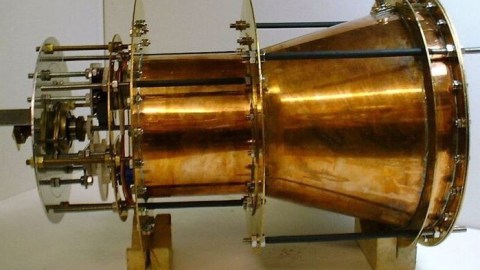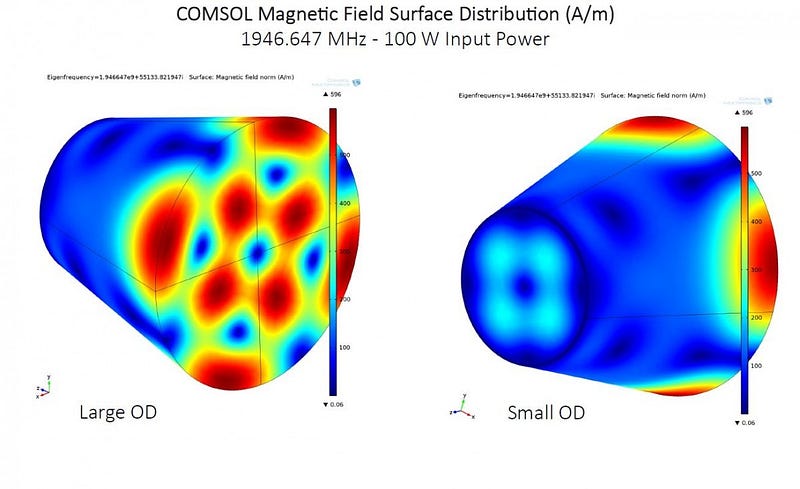NASA’s impossible space engine, the EMdrive, passes peer review

But that doesn’t mean it actually works as advertised.
“All of the books in the world contain no more information than is broadcast as video in a single large American city in a single year. Not all bits have equal value.” –Carl Sagan
“For every action, there’s an equal and opposite reaction.” So goes Newton’s third law, and despite the developments of relativity and quantum mechanics, that fundamental law of the Universe — otherwise known as the conservation of momentum — has never been challenged. Yet a few years ago, a new space drive that claims to break that exact law was proposed and put forth by inventor Roger Shawyer, the EMdrive. Unlike conventional rocket engines, which cause thrust in one direction by propelling exhaust outwards in the opposite direction, the EMdrive claims to take an external source of power and convert it into a positive thrust with no corresponding reaction.
And despite the fact that this seems to violate the known laws of physics, a prototype device was submitted to NASA’s Eagleworks lab for testing. Perhaps surprisingly, the test came back positive: there was thrust observed despite the lack of a reaction. And if Dr. José Rodal from the NASA Spaceflight forums can be trusted, the paper resulting from the test, “Measurement of Impulsive Thrust from a Closed Radio Frequency Cavity in Vacuum” by Harold White et al., was just accepted for publication in the peer reviewed Journal Of Propulsion And Power, by AIAA.

But what does that mean? What does being accepted for publication in a peer-reviewed journal mean? Does it mean the science is correct, the effect is real and that physics is broken? Consider that peer-reviewed journals publish all sorts of results that later turn out to be spurious, including:
- the faster-than-light neutrinos that turned out to be a loose cable,
- the existence of the exoplanet Alpha Centauri Bb, which turned out to not exist,
- and the existence of a new LHC particle at 750 GeV, whose signal went away with more data.
What it means to be peer-reviewed is that an independent scientist who is an expert in the particular field read and reviewed the work undertaken, and found it to be of sufficient quality to be a valuable contribution to the field. It does not mean that the results and conclusion of the paper are necessarily correct, or even the last word on that particular issue.

What has happened here is that a device has been designed that, when large amounts of power are pumped into it, tiny amounts of thrust are observed. The thrust-to-power ratio observed is 1.2 ± 0.1 Newtons per Megawatt, where 1.2 Newtons is the equivalent of the weight of an iPhone 6, while a Megawatt is enough energy to power everything in your entire house… and 649 others, all at once. Which is to say, it’s an incredibly large amount of power required for an incredibly tiny amount of thrust. Nevertheless, if you break the laws of physics, and you do it with such small measurement uncertainty compared to the signal you measure, surely that’s meaningful, important and robust, right?

If you’re going to make an extraordinary claim like this — which violates the laws of physics — you’d better have extraordinary evidence to back it up. In particular, the laws you’re violating are really basic: Newton’s third law, since you’re having an action (thrust) without a corresponding reaction, and the law of conservation of momentum. The claimants propose no viable mechanism, but merely contend that all of science is experimental, so if the experiment gives you this thrust, then it’s our understanding of physics that needs revision, not the experiment. For the EMdrive, the device that was tested here, thrust was consistently observed on the device to be between 30-and-50 microNewtons, giving us that 1.2 N/MW figure. But the limits of the measuring device’s threshold was just 10-to-15 microNewtons! In other words, these results may be consistent and interesting, but this isn’t as robust as anyone wants it to be.

These marginally positive results made it past peer review, and surely many people with dreams of a new form of energy and breaking the laws of physics will be bolstered by this new step. But don’t let this fool you into the type of hype that typically ensues: the promise of free energy, of limitless propulsion and even of interstellar travel. Until this device can be scaled-up and its effects reproduced, harnessed and put to use, it’s worth remaining highly skeptical. A few successful, small-scale tests might be evidence that we really have something interesting here, or it could be evidence of one of the hallmarks of tinkerers who work with perpetual motion machines, free energy machines and other device along those lines: you are dealing with someone who has confused themselves by constructing something that they do not understand.

I believe this is what Shawyer did, and has been essentially sending this device to others and saying, “what did I do, here?” And the answer is, Roger, that you built something you do not understand, it does something you don’t understand, and because it isn’t obvious, the people you’re sending it to likely don’t understand it either. But that doesn’t mean it isn’t understandable; it only means that if it is, the people who’ve looked at it haven’t figured it out yet. If I were to hazard a guess, I would bet that there likely is exhaust that just hasn’t been detected yet, and this exhaust is the equal-and-opposite reaction required to explain the forward thrust observed. And getting this published in a peer-reviewed journal doesn’t change any of that. As Richard Feynman eloquently put it so many decades ago:
For a successful technology, reality must take precedence over public relations, for nature cannot be fooled.
This post first appeared at Forbes, and is brought to you ad-free by our Patreon supporters. Comment on our forum, & buy our first book: Beyond The Galaxy!





